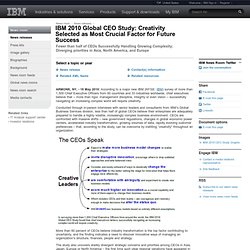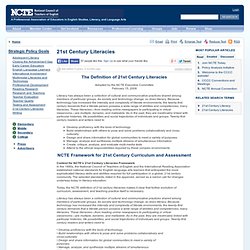

2010-05-18 IBM 2010 Global CEO Study: Creativity Selected as Most Crucial Factor for Future Success. ARMONK, NY, - 18 May 2010: According to a major new IBM (NYSE: IBM) survey of more than 1,500 Chief Executive Officers from 60 countries and 33 industries worldwide, chief executives believe that -- more than rigor, management discipline, integrity or even vision -- successfully navigating an increasing complex world will require creativity.

Conducted through in-person interviews with senior leaders and consultants from IBM’s Global Business Services division, less than half of global CEOs believe their enterprises are adequately prepared to handle a highly volatile, increasingly complex business environment. CEOs are confronted with massive shifts – new government regulations, changes in global economic power centers, accelerated industry transformation, growing volumes of data, rapidly evolving customer preferences – that, according to the study, can be overcome by instilling “creativity” throughout an organization. Managing complexity One World, Diverging Views. 21st Century Literacies. The Definition of 21st Century Literacies Adopted by the NCTE Executive CommitteeFebruary 15, 2008 Literacy has always been a collection of cultural and communicative practices shared among members of particular groups.

As society and technology change, so does literacy. Because technology has increased the intensity and complexity of literate environments, the twenty-first century demands that a literate person possess a wide range of abilities and competencies, many literacies. These literacies—from reading online newspapers to participating in virtual classrooms—are multiple, dynamic, and malleable. Common Core State Standards Initiative. Framing. Kaplan Training Day 1. SandraKaplan-Theory and Practice. YouTube. Think Like A... Think Like A ... Lesson Template. YouTube. YouTube. Kaplan's Lesson Construction. Lesson Plan Construction - Project Linking Learning D&C Test Taking Skills. D&C Language Arts Example. Depth and Complexity with The Lorax - Terri Eichholz. ELA Reflection with Depth and Complexity.
Icons of Depth and Complexity. Since the beginning of the year, students have been learning about the prompts of depth and complexity.
Teachers tie the prompts in the questions they ask and by asking the students to analyze information. After the students become familiar with these prompts, we teach the students the purpose of having the prompts and how to apply them. Our goal is to have the children be able to use these prompts to develop their own questions that are analytical and evaluative versus factual questions. We start by defining prompts as a catalyst to excite thinking, a stimulus to arouse curiosity, and a springboard to spark or ignite an idea, or as a means to give directions. Students are asked to think about real world examples of prompts they see at school, at home, and at the mall. At School The school bells prompt us to line up.The fire alarm prompts us to evacuate the classroom.Writing prompts tell us what to write.Teachers have their own signal to call the class to attention. At the Mall At Home. Icon Chart. D&C. D&C Chart. Flow_chart. Depth & Complexity. Book Review.